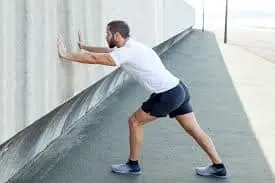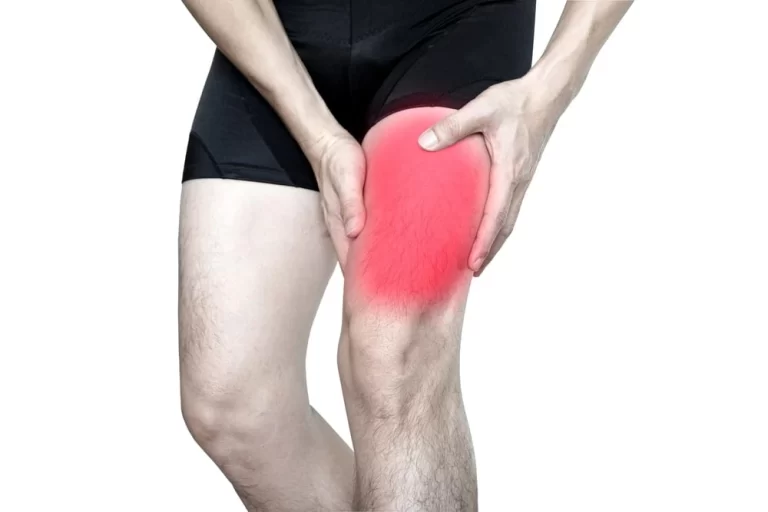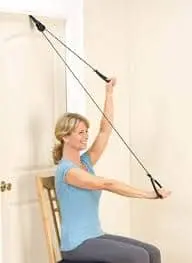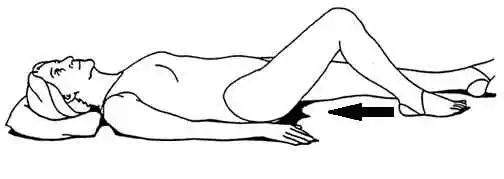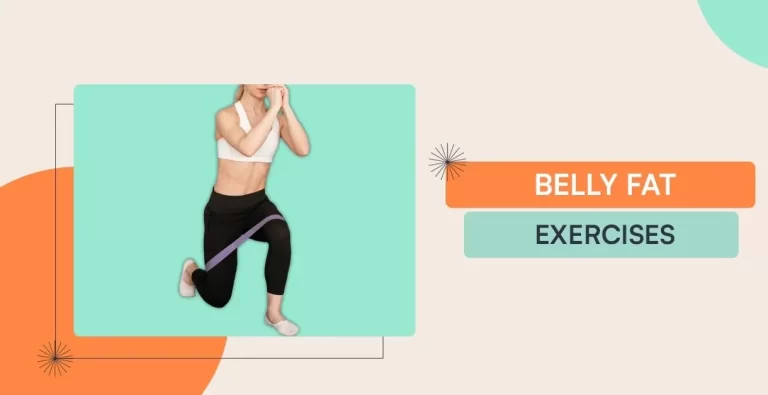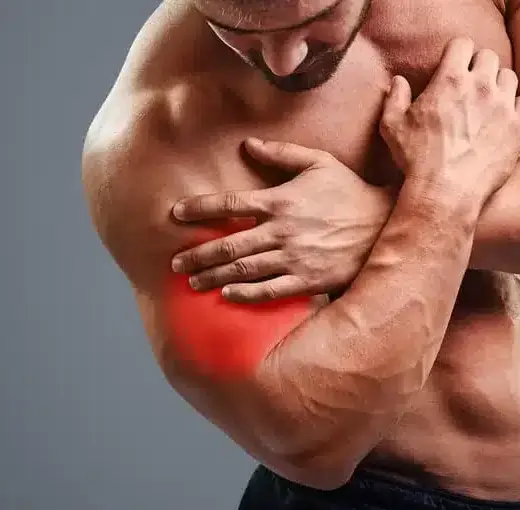12 Best Exercise for Achilles Tendinitis
Introduction:
Exercise for Achilles tendinitis plays a crucial role in managing and rehabilitating this condition. Proper stretching and strengthening exercises can help alleviate pain, improve flexibility, and promote healing.
The healing process for Achilles tendinitis may benefit from a variety of stretches and strengthening activities. Exercise for Achilles Tendinitis lowers pain and inflammation while offering stability and support.
An overuse condition known as Achilles tendinitis affects the Achilles tendon, which is the band of tissue connecting the calf muscles at the back of the lower leg to the heel.
Runners who suddenly increase the length or intensity of their runs are more likely to develop Achilles tendonitis. For middle-aged persons, playing sports like basketball, volleyball, tennis, and running just sometimes or on the weekends is fairly typical.
Cases of Achilles tendinitis can be managed at home under the guidance of your healthcare provider. Techniques for self-care are vital to preventing ongoing difficulties. Tendon rupture in more severe forms of Achilles tendonitis may require surgical correction.
Causes:
Repetitive strain on the tendon is the cause of the issue. This frequently happens when we overwork our bodies too quickly, but other variables can increase the risk of tendinitis, such as;
- Not getting enough warm-up
- A sudden increase in the quantity or intensity of physical activity, such as going up the distance you run each day by a few miles without allowing your body to get used to the new distance.
- Achilles tendon damage may result from rapidly beginning a rigorous workout routine and having tight calf muscles.
- Pain may result from the Achilles tendon rubbing up against a bone spur, which is an additional growth of bone where the tendon attaches to the heel bone.
Signs and symptoms:
- Pain that becomes worse with movement along the tendon or heel’s back.
- Bone spur formation
- In the early morning hours, the Achilles tendon is painful and stiff.
- Swelling is constant and worsens with exercise throughout the day.
- A sudden pain in the heel or lower leg.
- The tendon’s thickness
Exercise for Achilles Tendinitis:
Standing calf stretch
- Touch the wall or a chair with your hands.
- Place your hands at eye level if you’re using a wall.
- Stepping the leg you want to stretch behind you is necessary.
- Maintain your rear heel firmly on the ground while pointing your toes directly ahead.
- When the opposite leg remains straight, bend the opposing knee toward the wall.
- Your calf should begin to stretch a little as you press towards the wall.
- Avoid leaning so much that it hurts you.
- Hold this position for a few seconds.
- Then return to your neutral position.
- Then relax.
- Repeat this exercise five to ten times.
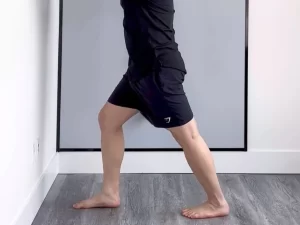
Seated calf stretch
- You will have the option of sitting on the floor or on a bed.
- You can extend the foot by bending your knee slightly and wrapping a resistance band around its heel.
- Use your hands to grasp the ends.
- Pulling the strap will help you stretch your foot in your direction.
- Hold this position for a few seconds.
- Then return to your neutral position.
- Then relax.
- Repeat this exercise five to ten times.
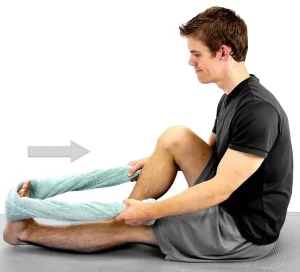
Heel drop
- Simply place the front half of your foot on the stair while standing at the edge of a stair or a secure elevated platform.
- In this position, your heel can move up and down without connecting with the stairs.
- To avoid falling and getting hurt, it’s important to take care of your state of balance.
- To help you balance, make sure you’re holding onto a railing.
- Raise your heels off the floor and then gradually bring them down to the lowest position.
- Then return to your neutral position.
- Then relax.
- Repeat this exercise five to ten times.
- It is best to perform this exercise slowly and carefully.
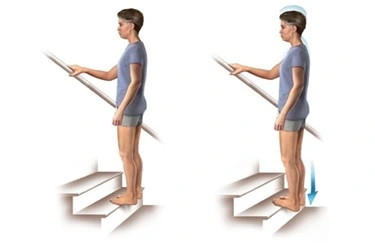
Single-leg heel drop
Similar to the heel drop, this exercise involves concentrating all of your weight on one leg.
- Begin by standing on a stool or stair.
- The heel of your foot should be on the outside of the step.
- Allow your other foot to relax by letting your heel droop.
- Hold this position for a few seconds.
- Then return to your neutral position.
- Then relax.
- Repeat this exercise five to ten times.

Seated heel raise
- Sit down and place your feet flat on the ground to begin.
- Raise your heels by applying pressure via the heel of your feet.
- Maintaining a neutral ankle posture is important.
- Avoid rolling your ankles outward.
- Hold this position for a few seconds.
- Then return to your neutral position.
- Then relax.
- Repeat this exercise five to ten times.
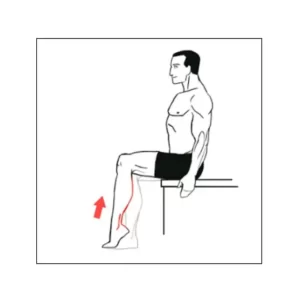
Standing heel raise
- Maintain a shoulder-width distance between your feet.
- To get support, hold to a chair or counter.
- Rise onto the heel of your feet by lifting your heels.
- Hold this position for a few seconds.
- After a moment, carefully drop your heels.
- Then return to your neutral position.
- Then relax.
- Repeat this exercise five to ten times.
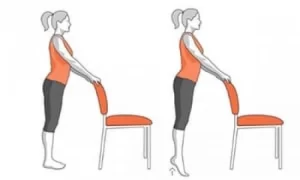
Soleus stretch
- Arrange your feet while keeping your injured leg in the back as you face a wall.
- Put your back foot’s heel down on the floor.
- Then slightly bend your painful leg’s knee.
- Transfer your weight toward the wall without lifting your injured heel off the ground.
- As soon as your lower calf starts to stretch, stop.
- Hold this position for a few seconds.
- Then return to your neutral position.
- Then relax.
- Repeat this exercise five to ten times.
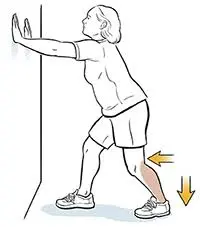
Toe-to-wall stretch
- Position yourself on the floor so that your toes are up against the wall.
- The deeper the stretch, the higher you place your toes.
- Keep your heel planted on the floor and lean forward.
- With the heel on the ground and the toes forward, your other leg is behind you.
- Hold this position for a few seconds.
- Then return to your neutral position.
- Then relax.
- Repeat this exercise five to ten times.
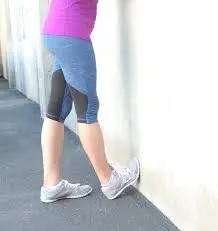
Toe raises
- Place your feet level on the ground when you begin standing.
- Now raise the toes of both legs.
- Hold this position for a few seconds.
- Then return to your neutral position.
- Then relax.
- Repeat this exercise five to ten times.
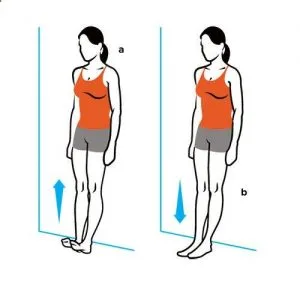
Toe walk
- Stand up at the beginning.
- For support, you might wish to hold on a counter or railing.
- To raise your heels off the ground, contract your calf muscles.
- Keeping your heels high, take several steps forward on your tiptoes.
- Avoid dropping your heels on the floor.
- Walk at least a few meters, then turn around and walk back.
- Then return to your neutral position.
- Then relax.
- Repeat this exercise five to ten times.
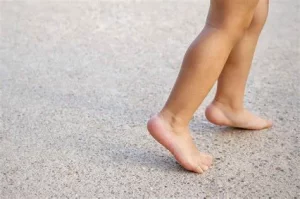
Single-leg raise
- Standing with both feet flat on the floor, you can balance yourself if necessary by holding onto a chair or countertop.
- Elevate your right foot off the ground and bend it at the knee to balance on your left hand.
- You can stand on your tip toes by lifting your heel off the ground and applying pressure to the heels of your feet.
- Hold this position for a few seconds.
- Then return to your neutral position.
- Then relax.
- Repeat this exercise five to ten times.
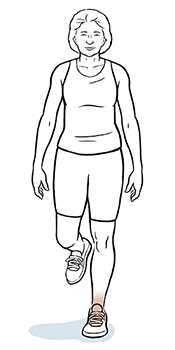
Seated toe taps
- The first step is to sit down on the chair.
- Elevate your toes gradually to the ceiling while maintaining your heels flat on the ground.
- Hold this position for a few seconds.
- Then return to your neutral position.
- Then relax.
- Repeat this exercise five to ten times.
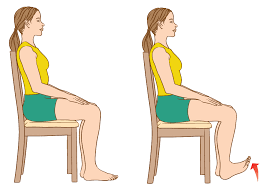
What safety measures should be taken when exercising?
- Exercise should be stopped as soon as the pain gets really bad.
- When you’re exercising, straighten your posture.
- Try not to use any force or rapid motions when exercising.
- Before and after sets, as well as for the number of repetitions recommended for each exercise, you should stretch according to the protocol.
- To improve your range of motion and encourage relaxation, dress comfortably and loosely when working out. Avoid wearing anything too tight or trendy.
- It’s crucial to stretch and bend gently.
- Look for yourself and maintain your focus to prevent falling out while working out.
- Between workouts, take a break.
- Stretching the muscles in your tense joints is normal, even though it could be difficult at times. Stretching and exercise shouldn’t hurt or feel like someone is stabbing you because they are bad for you and worsen your illness.
- Stay hydrated.
When are you going to stop working out?
- A fever
- Stop exercising if it causes pain.
- Burning sensation in the muscles.
- You don’t feel good.
- If numbness or pain are present.
- Blurred vision
- A headache
What to do and not do when recovering from Achilles tendinitis:
With the right rehabilitation, Achilles tendonitis usually heals completely. Complete rest is not advised, but you should refrain from activities that aggravate your condition. The Achilles tendon needs training and gradual, moderate pressure to heal properly.
When recovering from tendinitis in the Achilles;
Do:
- Stop doing things that aggravate you, like running and jumping, for a while.
- Don’t spend too much time walking and standing around.
- Get your calf muscles working.
- Visit a physical therapist.
- Try taking medicine and using ice to ease your pain.
- Put supportive shoes on.
Don’t:
- Push yourself through your workouts.
- Completely rest after exercising.
- Enter high-impact exercises too quickly, such as sprinting or jumping.
- Run or walk on uneven or steep surfaces.
Precaution:
- Strengthen your calf muscles
By reducing the strain on the Achilles tendon, strong calf muscles can lower the chance of injury. Exercises that target your calves and lower limbs for strength will help heal the area and lessen your chance of getting the condition. However, while the patient is recovering, some cases of Achilles tendonitis shouldn’t be fixed. Therefore, before starting any form of activity, it is necessary to speak with a podiatrist, physical therapist, or doctor.
- Take a break in between exercises
Muscles are more likely to suffer injuries and any microtears that do occur can get worse if you don’t give your body time to recover between strenuous workouts. This is especially true if you’re not used to being physically active for extended periods. After working out or participating in sports, you should rest until you feel normal again if you have any soreness.
- Your lower legs should be stretched
Stretches, similar to strengthening exercises, can help prevent and treat Achilles tendonitis. As a preventative step, stretches can help in improving this area’s flexibility, which can help to prevent injuries. By relaxing the affected area, stretching can be used as a treatment to help bring relief. You can especially focus the calf and Achilles regions using the stretches listed above.
- Select the right shoes
Choosing the right shoes is important because poorly supported or ill-fitting shoes can lead to Achilles tendinopathy. Your Achilles tendon will be used when you exercise, especially when you’re doing aerobic or cardio exercises, so it’s important that your shoes fit properly and offer enough support to avoid injury. It can also greatly relieve tension in the tendon.
Summary:
Achilles tendonitis is a painful but frequent ailment. Physical therapy activities can be used to treat it in most cases. Extreme pain and stiffness may result, making walking difficult and carrying out regular duties difficult.
Because stretching the tendon increases mobility and loosens the heel cord, it may help in the recovery of those who have had Achilles tendon damage. People who have injured their Achilles tendon may also benefit from strengthening their calves. The calf and heel muscles that are connected to the tendon can also be toned by strengthening exercise sessions. Less strain will be placed on the tendon by stronger muscles. You can heal from Achilles tendonitis by performing exercises at home that a physical therapist (PT) can show you.
Before performing stretches and strengthening exercises for your Achilles tendon, see your physician. Resting and reducing activity is crucial throughout the healing process. The safest way to resume your regular activities might be explained by your physician.
FAQ:
For Achilles tendonitis, is walking beneficial?
It’s fine to walk quickly in these situations if it feels comfortable; but, if it hurts too much, think about using a heel cushion insert that provides support (found at most pharmacies).
Which exercise equipment is ideal for treating Achilles tendonitis?
Resistance bands are useful for strengthening activities that don’t overstress your tendons.
You can massage and relax your tense calf muscles with foam rollers.
You can develop your lower leg muscles and improve your stability by using balance boards.
What symptoms can indicate Achilles tendonitis?
Walking or running might cause pain in the heel and down the tendon’s length. In the morning, the area was painful and stiff. Achilles tendon pain upon movement or contact.
How may Achilles tendinitis be avoided?
To give your tendon time to heal, you should reduce or stop unpleasant exercises like running and jumping. Engage in activities that don’t overstress the tendon, such as swimming or cycling.
How can someone who has Achilles tendinitis sleep?
It is possible to lessen tendon mobility and edema by applying compressive elastic bandages or wraps. To minimize edema, elevate the affected foot above your heart.
Does barefoot walking help with Achilles tendonitis?
Walking up barefoot or standing on a ladder rung will cause your tendon to stretch excessively. Put on supportive footwear, heel lifts, or custom orthotics. Do not walk barefoot.
Can the Achilles tendon recover by itself?
The majority of Achilles tendon injuries that are modest to moderate heal on their own. One way to expedite the process is to: Rest your leg. Avoid placing any weight on it as frequently as you can.
How can Achilles tendinitis be healed fastest?
Proper rest, focused workouts, and a gradual return to physical activity are the best ways to recover from Achilles tendonitis. Resting your tendon from activities that strain it, such as jogging and leaping, is crucial when you’re first recovering from Achilles tendonitis. With focused exercises, you can progressively increase your level of physical activity once you’ve gained strength.
What is the duration of Achilles tendonitis?
Keep in mind that the pain associated with Achilles tendinitis may persist for at least two to three months. If the pain persists, surgery may be required to remove aberrant tendon regions and inflammatory tissue. Surgery can be required to remove a bone spur that is irritating the tendon.
Which is better for Achilles tendonitis: heating or ice?
To help reduce pain and prevent additional tendon strain or tears around the heel area, apply cold to your Achilles.
References:
- On May 24, 2024, Ocs, T. P. D. Exercises for Achilles Tendonitis. Verywell Health. Exercises for Achilles tendonitis: https://www.verywellhealth.com/pt-exercises-for-5202656
- April 5, 2023: Prajapati, D. The Best Achilles Tendinitis Exercises by Samarpan Physio. Physiotherapy Clinic of Samarpan. These are the best exercises for Achilles tendinitis, according to Samarpan Physio Clinic.
- AAOS, OrthoInfo, Achilles Tendinitis (n.d.). OrthoInfo.Aaos.org/en/diseases–conditions/achilles-tendinitis/
- On April 3, 2023, Nunez, K. Strength Training and Achilles Tendon Stretches. https://www.healthline.com/health/achilles-tendon-stretch Healthline
- The best stretches and exercises for Achilles tendinopathy. (October 23, 2001). People with feet. The best stretches and exercises for Achilles tendinopathy can be found at https://www.thefeetpeople.com.au/learning-hub/
- (n.d.) 1oahct.com. Household Exercises for Achilles tendinitis. https://oahct.com/wp-content/uploads/2020/04/OAH-ACHILLES-TENDINITIS-EXERCISES.pdf
- Image 3, (2018, June 19) Bowler, T. Preventing Injury While Running…Is the “Running Bug” bothering you now that spring has arrived? — Dr. Tammy Bowler, Huntsville chiropractor, is back in balance in Muskoka. Dr. Tammy Bowler, the Huntsville chiropractor, is back in balance in Muskoka. Chiropractic health articles and resources for 2018/6/18/running injury prevention: http://backinbalancemuskoka.ca Are you having the running bug now that spring has arrived?
- Image 12, Legs Matter. Published June 1, 2023. Easy exercises for the lower limbs to maintain the health of the feet and legs. https://legsmatter.org/resources/patient-legs-and-feet exercises/

